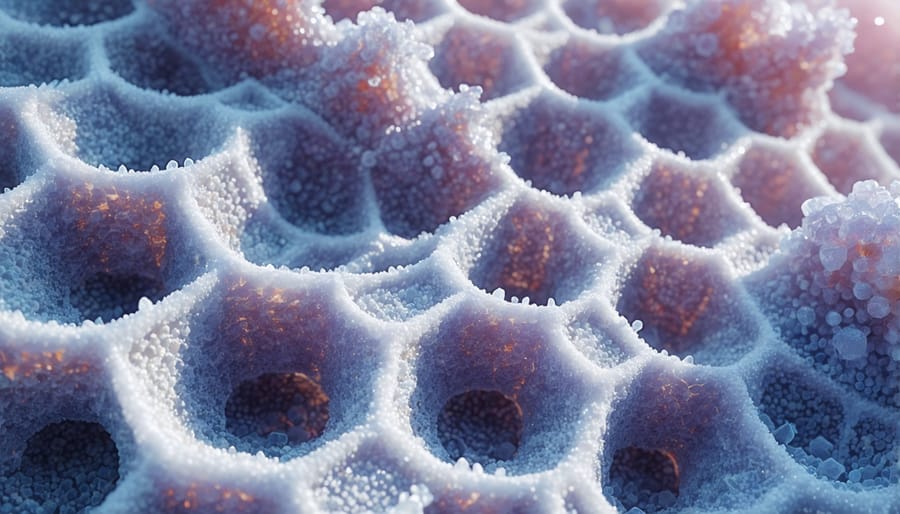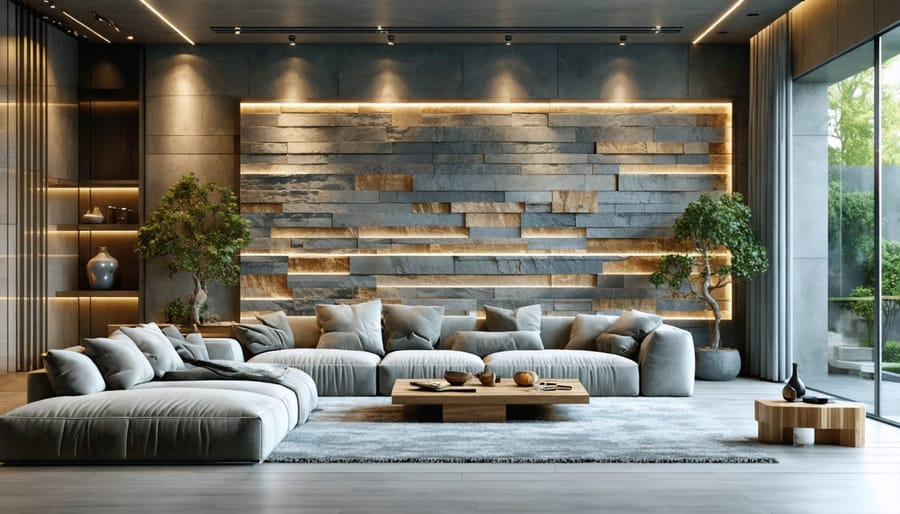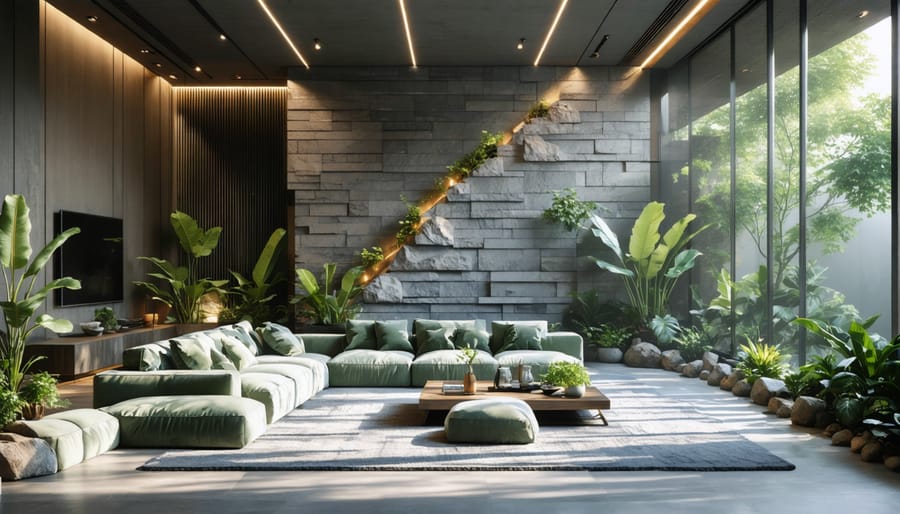Zeolites represent one of nature’s most fascinating molecular architectures, revolutionizing how we approach sustainable building materials and biophilic design principles. These crystalline aluminosilicate minerals, with their unique honeycomb structure and remarkable ion-exchange capabilities, have emerged as pivotal elements in modern architectural applications and environmental solutions. Recent studies have demonstrated zeolites’ exceptional ability to purify indoor air, regulate humidity, and reduce harmful volatile organic compounds (VOCs) by up to 80% in controlled environments.
As architects and designers increasingly prioritize wellness-focused spaces, zeolite integration has evolved from purely industrial applications to becoming a cornerstone of health-conscious building design. Their natural origin and proven effectiveness in creating healthier indoor environments align perfectly with both contemporary sustainable architecture and traditional building wisdom. The growing body of research supporting zeolites’ biophilic benefits has sparked a renaissance in their application, from specialized air filtration systems to innovative building materials that actively contribute to occupant wellbeing.
This convergence of ancient mineral science and modern architectural needs opens new possibilities for creating spaces that not only shelter but actively promote human health and environmental sustainability.
Understanding Zeolite’s Natural Properties
Molecular Structure and Formation
Zeolites possess a fascinating crystalline structure composed of three-dimensional frameworks of silicon-oxygen and aluminum-oxygen tetrahedra. These microscopic structures create a honeycomb-like network of uniformly sized pores and channels, typically ranging from 3 to 10 angstroms in diameter. The unique arrangement allows zeolites to act as molecular sieves, selectively filtering particles based on size and shape.
The formation of zeolites occurs naturally in alkaline environments where volcanic rocks and ash layers react with alkaline groundwater. This process, which can take thousands of years, results in the creation of various zeolite frameworks. Each framework type features distinct pore sizes and channel arrangements, leading to more than 40 naturally occurring zeolite species.
Scientists have also developed synthetic zeolites by replicating these natural formation conditions in laboratory settings. This controlled synthesis allows for the creation of zeolites with specific pore sizes and chemical compositions, tailored for particular applications. The resulting structures maintain their stability across a wide range of temperatures and conditions, making them valuable for industrial and environmental applications.

Natural Occurrence and Types
Zeolites occur naturally in various geological settings, primarily forming where volcanic rocks and ash layers react with alkaline groundwater. The most common natural zeolites include clinoptilolite, mordenite, and chabazite, each possessing unique structural characteristics and properties.
These minerals typically form in volcanic regions where ash deposits have undergone alteration over thousands of years. Significant deposits can be found in countries like the United States, particularly in states such as Oregon, Arizona, and Idaho. Other major deposits exist in Cuba, Italy, and regions throughout Eastern Europe.
Natural zeolites exhibit diverse compositions and structures, resulting in varying pore sizes and cation exchange capacities. Clinoptilolite, the most abundant natural zeolite, features a distinctive honeycomb structure that makes it particularly effective for water filtration and environmental applications.
The formation conditions of natural zeolites influence their physical and chemical properties, with factors such as temperature, pressure, and chemical environment playing crucial roles. These variations create zeolites with different degrees of crystallinity, purity, and functionality, making each deposit unique in its characteristics and potential applications.
Biophilic Benefits of Zeolite Surfaces
Air Purification Properties
Zeolite’s remarkable air purification capabilities stem from its unique microporous structure, making it one of nature’s most effective indoor air purification methods. The mineral’s crystalline framework acts as a molecular sieve, naturally filtering harmful substances from the air through a process called selective adsorption.
When incorporated into living spaces, zeolite actively captures and retains various airborne pollutants, including volatile organic compounds (VOCs), formaldehyde, and ammonia. Its honeycomb-like structure creates countless microscopic chambers that trap these unwanted particles while allowing clean air to flow through. This natural filtration process continues 24/7 without requiring external power or mechanical intervention.
Research has shown that zeolite is particularly effective at reducing common indoor air contaminants such as cigarette smoke, pet odors, and cleaning product fumes. The mineral’s ion-exchange properties also enable it to neutralize certain toxic gases and remove excess moisture from the air, helping to maintain optimal humidity levels and prevent mold growth.
What makes zeolite especially valuable for indoor applications is its long-lasting effectiveness and minimal maintenance requirements. Unlike synthetic air filters that need regular replacement, zeolite maintains its purification properties for extended periods, requiring only occasional exposure to sunlight or heat to rejuvenate its filtering capacity.

Humidity Regulation
Zeolites excel in humidity regulation thanks to their unique microporous structure, which allows them to effectively absorb and release moisture as needed. This natural material acts as a molecular sieve, maintaining optimal indoor humidity levels between 40-60%, which is ideal for human comfort and health.
In buildings, zeolite-based systems work passively to prevent excessive moisture buildup while also protecting against overly dry conditions. The material’s honeycomb-like structure can absorb up to 40% of its weight in water vapor during periods of high humidity and release it when the air becomes too dry. This self-regulating property makes zeolites particularly valuable in spaces prone to moisture fluctuations, such as bathrooms, basements, and poorly ventilated areas.
Research has shown that zeolite-enhanced building materials can significantly reduce the need for mechanical dehumidification systems, leading to energy savings and improved indoor air quality. The material’s moisture-buffering capacity helps prevent common moisture-related issues such as mold growth, condensation, and material degradation.
For optimal performance, zeolites can be incorporated into various building components, including wall panels, ceiling tiles, and decorative elements. Their effectiveness in humidity control remains consistent over time, requiring minimal maintenance while providing long-term moisture management benefits.
Electromagnetic Radiation Absorption
Recent studies have demonstrated zeolite’s remarkable ability to absorb and mitigate electromagnetic radiation, making it increasingly valuable in modern environments where electronic devices are ubiquitous. Research indicates that zeolite’s unique crystalline structure can effectively reduce electromagnetic field (EMF) exposure by up to 30% when properly implemented in building materials and protective applications.
Laboratory tests have shown that zeolite’s negatively charged framework naturally attracts and captures positively charged particles, including those generated by electromagnetic radiation. This absorption capacity extends across various frequencies, from low-frequency emissions produced by household appliances to higher-frequency radiation from wireless devices.
Notable findings from independent research facilities have documented zeolite’s effectiveness in reducing EMF penetration through walls and surfaces where it has been incorporated. When used in construction materials, zeolite-enhanced products have demonstrated consistent EMF-blocking properties without degrading over time.
The practical implications of these studies are particularly relevant for spaces where EMF reduction is desired, such as bedrooms, home offices, and healthcare facilities. Architects and designers are increasingly incorporating zeolite-based materials into their projects, creating environments that offer enhanced protection against electromagnetic radiation while maintaining aesthetic appeal.
These protective properties, combined with zeolite’s other beneficial characteristics, make it an increasingly popular choice for wellness-focused building designs and renovations.
Practical Applications in Interior Design
Residential Uses
Zeolites have found increasing applications in residential settings, offering both functional and aesthetic benefits to modern homes. These versatile minerals are commonly integrated into natural stone surfaces and building materials, contributing to healthier living spaces through their unique molecular properties. In residential applications, zeolites excel at humidity regulation, helping maintain optimal indoor moisture levels between 40-60%, which can significantly improve air quality and comfort.
Popular residential implementations include zeolite-enhanced wall panels, which act as natural air purifiers by trapping airborne pollutants and neutralizing odors. These panels are particularly effective in bathrooms, kitchens, and basements where moisture control is crucial. Homeowners also incorporate zeolite materials in flooring solutions, where they help regulate temperature and reduce condensation issues.
Recent studies have shown that zeolite-integrated building materials can reduce indoor air pollutants by up to 40% and help maintain consistent humidity levels throughout the year. This makes them particularly valuable in regions with varying seasonal conditions or homes with moisture management challenges. Additionally, zeolite materials contribute to passive temperature regulation, potentially reducing heating and cooling costs while creating more comfortable living environments.
Many architects now specify zeolite-based materials for their projects, recognizing their contribution to sustainable and healthy home design. These applications align with growing consumer interest in non-toxic, environmentally conscious building materials that promote wellbeing.

Commercial Applications
Zeolites have become increasingly prevalent in modern commercial architecture, particularly in office buildings and public spaces where air quality and environmental sustainability are paramount concerns. These versatile minerals are integrated into sustainable design practices through various innovative applications.
In office environments, zeolite-based air filtration systems effectively remove volatile organic compounds (VOCs), formaldehyde, and other indoor pollutants. Major corporate headquarters, including the Bank of America Tower in New York and the Edge building in Amsterdam, utilize zeolite technology in their ventilation systems to maintain superior air quality for occupants.
Public spaces such as airports, shopping centers, and healthcare facilities benefit from zeolite applications in multiple ways. The material’s exceptional absorption properties help regulate humidity levels, while its natural antimicrobial characteristics create healthier environments in high-traffic areas. For example, the Singapore Changi Airport incorporates zeolite-enhanced materials in its air handling units to maintain optimal indoor air quality for millions of travelers annually.
Additionally, zeolite-based construction materials are increasingly used in wall panels and ceiling tiles, offering both acoustic benefits and air-purifying properties. These applications demonstrate how natural mineral solutions can enhance both the functionality and sustainability of commercial spaces while supporting occupant wellbeing.
Installation and Maintenance Considerations
Installation Best Practices
Proper installation of zeolite surfaces requires careful attention to detail and adherence to industry standards to ensure optimal performance and longevity. Begin by thoroughly cleaning and leveling the substrate surface, removing any debris or contaminants that could compromise adhesion. The substrate should be completely dry and structurally sound before proceeding.
Mix zeolite materials according to manufacturer specifications, paying particular attention to water-to-material ratios. Apply a suitable primer if recommended for your specific application, allowing it to cure fully before proceeding with the installation. Use appropriate trowels and tools to ensure even distribution and proper thickness of the zeolite mixture.
When installing zeolite panels or tiles, maintain consistent joint spacing and use recommended setting materials. Allow for proper expansion joints, especially in larger installations or areas subject to temperature fluctuations. Ensure adequate ventilation during installation, as proper air circulation aids in the curing process.
After installation, protect the surface from foot traffic and other disturbances for at least 24-48 hours, depending on environmental conditions and manufacturer recommendations. Seal the surface with an appropriate penetrating sealer once fully cured to enhance durability and stain resistance.
Regular maintenance inspections should be scheduled to check for any signs of wear or damage, allowing for prompt repairs when needed. Document all installation procedures and materials used for future reference and warranty purposes.
Long-term Care and Maintenance
To maintain zeolite’s effectiveness over time, regular monitoring and proper care are essential. Clean zeolite surfaces monthly using a soft brush and mild, pH-neutral soap to remove dust and debris that can clog the microporous structure. Avoid using harsh chemical cleaners or acidic solutions, as these can deteriorate the material’s molecular framework and reduce its absorption capabilities.
For indoor applications, maintain relative humidity levels between 30-60% to optimize zeolite’s moisture-regulating properties. In high-traffic areas, consider applying a breathable sealant every 12-18 months to protect the surface while preserving its natural properties. Regular visual inspections can help identify any signs of wear or damage that might require attention.
For outdoor zeolite installations, ensure proper drainage systems are in place to prevent water accumulation. Seasonal maintenance should include checking for frost damage in colder climates and cleaning any organic growth during warmer months. Replace or regenerate zeolite materials every 3-5 years, depending on exposure levels and usage intensity.
Document all maintenance activities and keep records of any treatments or repairs. This helps track the material’s performance over time and anticipate when replacement might be necessary. Professional assessment every two years can ensure optimal functionality and identify any potential issues before they become significant problems.
Zeolite studies have consistently demonstrated the remarkable versatility and effectiveness of these natural minerals in various applications. From air purification and water treatment to sustainable building materials, zeolites offer compelling benefits that merit serious consideration in modern design and construction. Their natural ability to trap pollutants, regulate humidity, and promote healthier indoor environments makes them an invaluable resource for creating wellness-focused spaces. By implementing zeolite-based solutions, architects and designers can enhance both the environmental performance and occupant well-being in their projects. As research continues to unveil new applications and benefits, the integration of zeolites in sustainable design practices represents a forward-thinking approach to creating healthier, more sustainable built environments. Consider incorporating these powerful natural minerals into your next project to harness their full potential.









